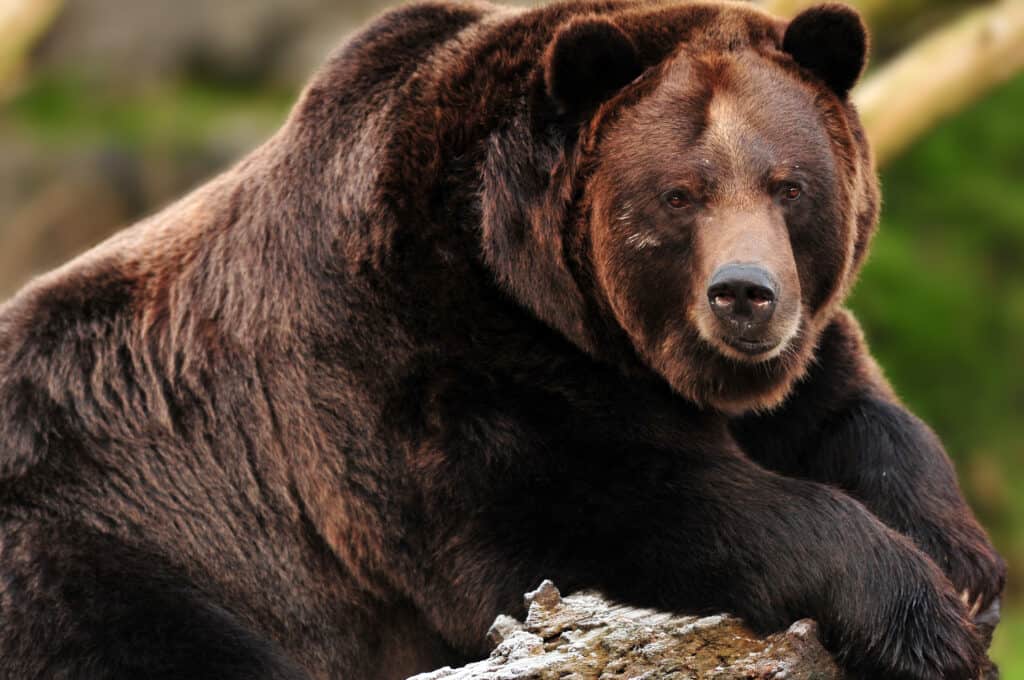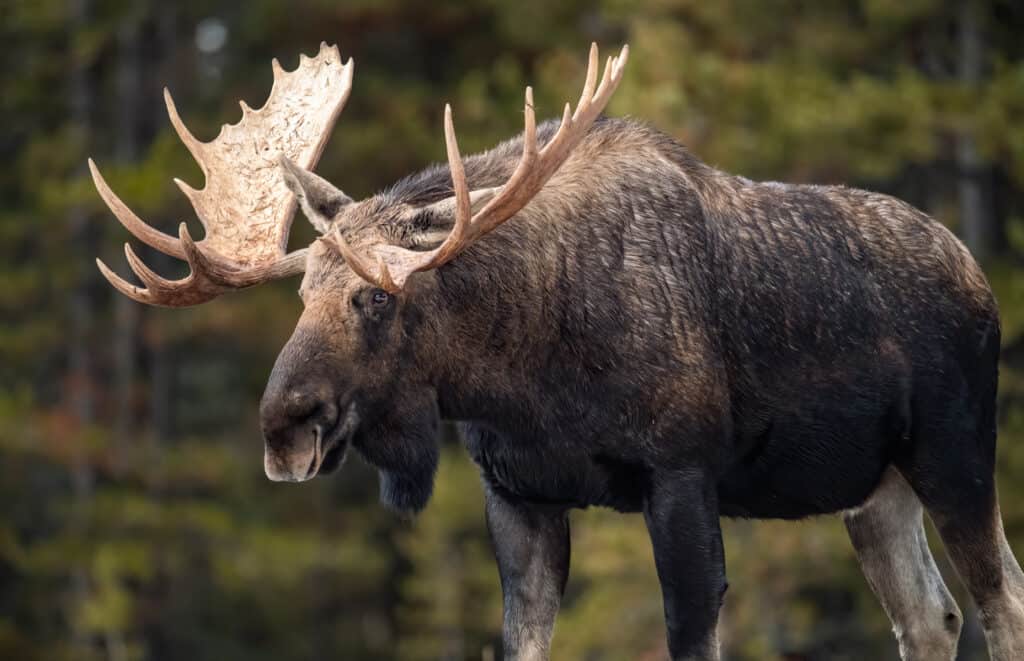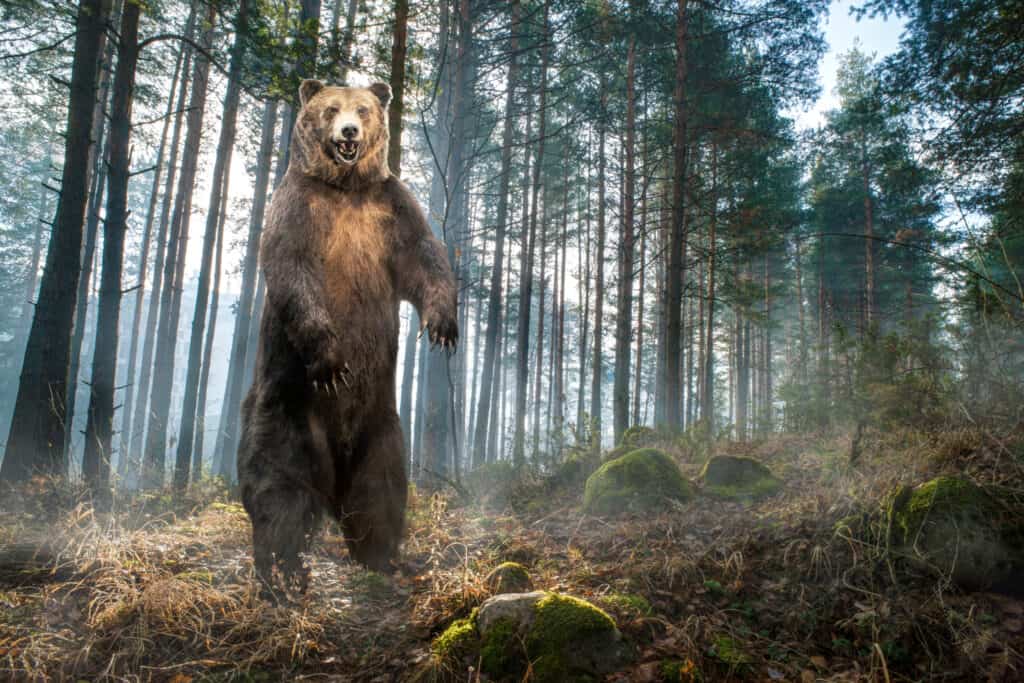Grizzly bears are impressive animals that have fascinated humans for centuries. Their imposing size and strength make them one of the most feared predators in North America. The largest grizzly bear ever recorded weighed more than a moose, which is an incredible feat considering that moose are one of the largest land animals in North America. Let’s explore why the largest grizzly bear ever grew so much.

What Is the Largest Grizzly Bear Ever Caught?
The largest grizzly bear ever recorded was captured in Alaska. The male bear was killed by a hunter named Larry Fitzgerald, who had been hunting with a guide in the Alaska wilderness.
The bear weighed an estimated 1,600 pounds and stood over 10 feet tall on its hind legs. The bear was estimated to be around 15 years old and had been known to local authorities as a problem bear, having been involved in several human-bear conflicts in the area.
The skull of the 2014 grizzly bear was also measured, and it was found to have a skull measuring 27 and 6/16 inches, making it the largest grizzly bear skull ever recorded.
Although the size of these bears is impressive, it’s worth noting that killing grizzly bears is widely debated among individuals. Many argue that these animals should be protected and allowed to live freely in their natural habitat. This is particularly important given that grizzly bears play a vital role as keystone species in several ecosystems and help preserve the balance of these systems.
Work is underway to safeguard grizzly bears and their habitats. This involves setting up “grizzly bear recovery zones” and taking steps to minimize conflicts between humans and bears. It’s important to safeguard these majestic creatures so that they can prosper in their natural environment and play a vital role in maintaining the health and diversity of our ecosystems.

The largest grizzly bear weighed an estimated 1,600 pounds and stood over 10 feet tall on its hind legs.
©neelsky/Shutterstock.com
What Is The Average Size Of A Grizzly Bear?
The average male grizzly bear stands around 7 feet tall and can weigh up to 860 pounds. The female is usually smaller, standing around 6 feet tall, and weighing 250-350 pounds. However, like with the most giant grizzly bear ever caught, there have been instances of bears that are larger than this. Some males can weigh up to 860 pounds, while females can weigh up to 455 pounds.
What Is The Average Size Of A Moose?
Moose come in different species, varying sizes based on age, nutrition, and location. The weight varies on the type of moose. They are usually among the largest land animals worldwide, weighing about 875-1,600 pounds (680 kg) on average. Their height can range from 6-7 feet (2 meters) to over 10 feet (3 meters). Adult male moose usually stand around 8 feet (2.4 meters) tall at the shoulder.
These impressive animals are genuinely awe-inspiring, and viewing one in the wild is an experience that should not be missed.

Moose are usually among the largest land animals worldwide, weighing about 875-1,600 pounds on average.
©Harry Collins Photography/Shutterstock.com
3 Reasons Why The Largest Grizzly Bear Recorded Grew So Big
The largest grizzly bear ever recorded was an incredible feat considering how large and powerful these animals are naturally. So what had to happen for this moose to grow so big?
Reason 1: Genetics
Genetics is one of the main reasons why this large grizzly bear grew more than normal. Grizzly bears have been around for thousands of years and have had plenty of time to evolve and adapt to their environment. Over time, bears with larger body sizes were more successful in hunting, mating, and surviving in the wild. As a result, these larger bears passed their genes to their offspring, creating a larger population of bears with larger body sizes.
Scientists have discovered that specific genes, such as those related to metabolism and growth hormones, impact the bear’s size. These genes produce growth hormone, which helps develop the bear’s muscle and bone tissue.
A grizzly bear’s diploid karyotype comprises 37 chromosome pairs and an average distance of 688 bp between heterozygous positions in this assembly. It is essential to consider other factors like diet and hibernation patterns when determining the size of grizzly bears.
Reason 2: Diet
The bear’s diet is vital to why the grizzly bear was so large. Grizzly bears are omnivores, which means they eat both plants and animals. Their highly varied diet includes everything from berries and nuts to fish, small mammals, and even larger prey.
Grizzly bears will often feed on salmon and other types of fish in areas where fish are abundant. These fish are high in protein and fat, essential nutrients for bears. The protein helps to build and repair muscle tissue, while the fat provides the energy needed to survive in the wild.
In areas where larger prey like elk are available, grizzly bears will also feed on them. By consuming these large prey, grizzly bears can gain more weight and grow larger than bears that only eat berries and nuts. These animals are also high in protein and fat, so they are an important part of a grizzly bear’s diet.
However, grizzly bears do not always have access to these large prey, especially in scarce food areas. In these situations, bears must rely on other food sources, such as berries, nuts, and small mammals. While these foods are not as high in protein and fat as larger prey, they still provide the nutrients for bears to survive and grow.
The quantity of food also plays a role in a grizzly bear’s physical development. Bears with access to abundant food sources can consume more calories and nutrients, allowing them to grow larger than bears with limited access to food.
Reason 3: Habitat
The third reason the biggest grizzly bear ever grew so big is habitat. Grizzly bears are found in various habitats, including forests, mountains, and tundra. Each of these habitats offers different resources and challenges, which can impact the size and growth of grizzly bears.
Grizzly bears can put on more weight and grow more significantly in areas with abundant food and a mild climate than in harsher environments. For example, bears that live in the coastal regions of Alaska have access to more fish and other food sources than those in the state’s interior. Coastal bears are generally bigger than bears that live inland.
Habitat also plays a major role in a grizzly bear’s physical development. Bears that live in areas with steep terrain and rugged landscapes tend to have more muscle mass than those in flat areas. This is because bears in these areas must work harder to climb and navigate their environment, building their muscles and strengthening them.
Another factor that can impact a bear’s size and growth is the density of the bear population. In areas with a high density of bears, there may be more competition for food and resources. This can make it harder for bears to get the nutrients they need to grow and thrive. In contrast, areas with a lower density of bears may offer more resources for individual bears, allowing them to grow larger.

Scientists have discovered that specific genes, such as those related to metabolism and growth hormones, impact the bear’s size.
©Degimages/Shutterstock.com
Conclusion
Ultimately, the size of a grizzly bear is determined by a combination of factors, including diet, habitat, and population density. A grizzly bear’s access to protein and fat-rich foods like fish and large game animals can allow them to gain more weight and grow bigger than bears with limited resources.
Certain rugged habitats or abundant resources can enable bears to grow larger due to the extra physical activity needed to navigate the environment and access more food. Finally, a bear’s population density in its habitat can also play a role, as more competition for resources can limit growth. Thus, much goes into creating the largest grizzly bear ever recorded.
The photo featured at the top of this post is © Lubos Chlubny/Shutterstock.com
Thank you for reading! Have some feedback for us? Contact the AZ Animals editorial team.






